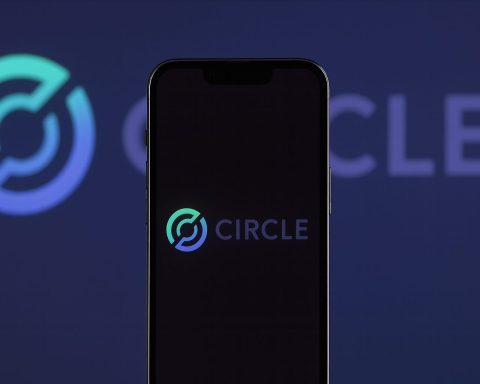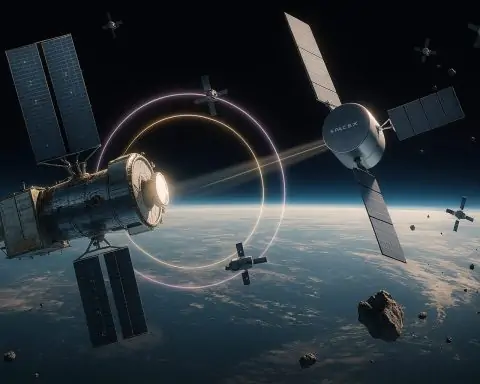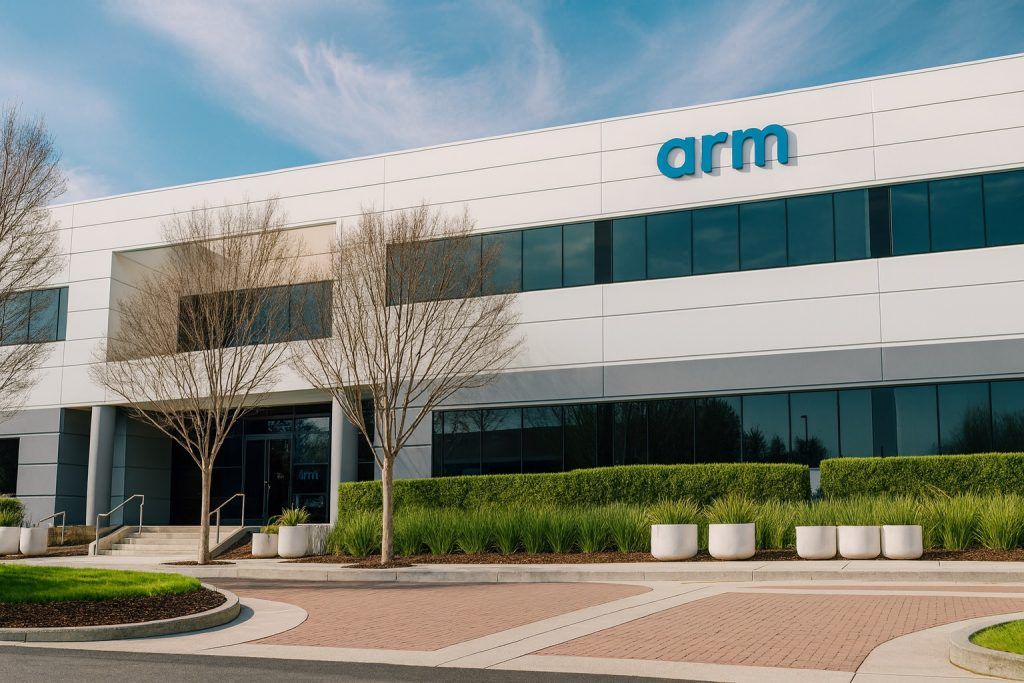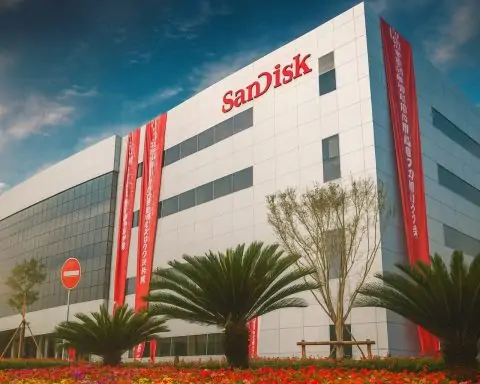- Stock Surge: Navitas Semiconductor (NVTS) stock jumped ~27% in mid-October 2025 after announcing new GaN/SiC power chips for NVIDIA’s 800‑volt AI data center architecture [1] [2]. The company’s shares have rocketed ~179% year‑to‑date on AI/EV excitement.
- NVIDIA AI Factory: NVIDIA’s roadmap calls for “AI factories” – massive AI server farms using 800V DC power rails (up from today’s ~50V racks). Navitas unveiled purpose‑built 100V GaN FETs and 650V GaN/SiC devices to enable this new architecture [3] [4].
- GaN/SiC Advantage: Gallium Nitride (GaN) and Silicon Carbide (SiC) chips switch far faster and run cooler than silicon. Navitas notes GaN devices can boost efficiency by ~40% and switch 100× faster than silicon [5] – crucial for multi‑megawatt AI racks.
- Industry Rush: Major partners are aligning on 800V DC. ABB, Vertiv, Renesas, Analog Devices and others announced 800V power systems and controllers for AI data centers [6] [7]. NVIDIA’s own blog reports 20+ companies are preparing for 800V DC “gigawatt AI factories” [8] [9].
- Navitas Strategy: Under new CEO Chris Allexandre (ex-Renesas), Navitas is pivoting from low‑margin phone chargers toward AI data centers, EVs and energy grids [10]. It raised $100M in Q2 2025 and is building a new GaN fab to meet anticipated demand [11]. The co‑founder envisions a ~$2.6B combined GaN/SiC market for AI by 2030.
- Analyst Views: Optimists call Navitas “one of the most important growth stories of the decade” [12]. Rosenblatt, Needham and others rate it a Buy (targets ~$8), citing long‑term AI/EV demand [13]. But skeptics warn the stock is richly valued (~30× forward sales) and much of the Nvidia news may already be “priced in” [14] [15]. Short interest (~25% of float) is very high, underscoring volatility [16].
Navitas Soars on Nvidia Collaboration
On Oct. 13, 2025 Navitas Semiconductor announced it had “developed advanced 800 VDC GaN and SiC power devices” for NVIDIA’s forthcoming AI data center architecture [17]. The market reacted immediately. NVTS stock closed ~21% higher (~$9.97) on Oct. 13 and surged to ~$12.71 (+27%) after hours [18]. (Seeking Alpha also reported NVTS up ~26% premarket Oct. 14 [19].) Analysts noted the trigger: Navitas’s press release confirmed it would supply GaN/SiC chips to enable NVIDIA’s new 800V DC “AI factory” power system [20] [21].
In other words, as Nvidia pushes a dramatic shift in data center design, Navitas stepped into the spotlight. CEO Chris Allexandre hailed the move: “As NVIDIA drives transformation in AI infrastructure, we’re proud to support this shift with advanced GaN and SiC power solutions that enable the efficiency, scalability, and reliability required by next‑generation data centers,” he said [22]. Industry observers call this NVIDIA endorsement a powerful validation of Navitas’s technology. One analyst quoted by TechStock² described Navitas as “one of the most important growth stories of the decade” given booming AI and EV power needs [23].
NVIDIA’s 800V “AI Factory” Revolution
What exactly is NVIDIA pushing? At an October 2025 Open Compute Project summit, NVIDIA and partners unveiled a vision for “gigawatt AI factories” – colossal AI data centers with megawatt‑scale GPU racks. Key to the design is an 800‑volt DC backbone. Moving from legacy ~415VAC/54VDC to 800VDC distribution can transport >150% more power using the same copper [24], dramatically improving efficiency and reducing materials. As NVIDIA’s blog explained, this 800V approach “[offers] increased scalability, improved energy efficiency, [and] simplified power distribution” [25].
Under this scheme, AC power is converted directly to 800VDC via high‑power rectifiers, then stepped down in two stages to GPU‑level voltages (e.g. 12V). NVIDIA’s new Rubin Ultra NVL144 rack and Kyber server platform (due by 2027) will use 576 Rubin Ultra GPUs on 800V rails [26] [27]. Industry heavyweights are already building out support: Taiwanese and cloud data centers (Foxconn, CoreWeave, Oracle Cloud, etc.) are designing 800V facilities, and 50+ hardware partners (HPE, Vertiv, ADI, Renesas, onsemi, etc.) showcased 800V power and cooling systems at the summit [28].
ABB’s Giampiero Frisio summed it up: “Through our collaboration, NVIDIA and ABB are supporting the industry in advancing toward 800 volt architectures that will enable the high‑density AI infrastructure needed to fuel the next generation of AI” [29]. NVIDIA’s own infrastructure chief Dion Harris added that this 800V shift is “fundamental” to unlocking next‑gen AI performance [30]. In short, the data center industry is broadly embracing NVIDIA’s 800V “AI factory” concept – and Navitas is now aligned to supply its core.
GaN and SiC: The Game-Changing Power Chips
At the heart of Navitas’s play are wide‑bandgap semiconductors: gallium nitride (GaN) and silicon carbide (SiC) power ICs. These materials can switch currents much faster and handle higher voltages than conventional silicon chips, with far less heat loss. Navitas’ GaNFast™ ICs monolithically integrate GaN transistors, drivers and sensing, enabling power conversion at higher frequencies and efficiencies. (Navitas also owns GeneSiC™, a top SiC device line.)
According to Navitas, GaN chips “can boost efficiency by up to 40% and switch 100× faster than silicon” [31] – a quantum leap for any power supply. This has already revolutionized smartphone and laptop chargers. The same gains are now chasing data centers. For example, Navitas’s new 100V GaN FETs (built on a 200mm GaN‑on‑Si process) are tuned for the 800V DC/DC converter stages on GPU boards [32] [33]. They promise higher density and thermal performance. Similarly, its 650V GaN portfolio and high‑voltage SiC MOSFETs cover the front end (rectification) and rack distribution stages [34].
Other industry players are also leveraging GaN/SiC. Renesas Electronics, a leading power chipmaker, notes that GaN’s “faster switching, lower energy losses, and superior thermal management” make it ideal for 800V infrastructure [35]. (Renesas just announced GaN-based converter modules reaching ~98% efficiency on AI workloads [36].) Analog Devices rolled out high-voltage hot‑swap controllers and converters designed for 800V AI racks, with GM Todd Sherman saying ADI’s controllers “have become essential for protecting these new AI systems” [37]. In essence, GaN/SiC devices like Navitas’s form the backbone of the new 800V power train – and that’s why investors got excited.
Industry Aligns Behind 800V Architecture
Navitas is not alone in the 800V race. Vertiv (data center infrastructure) and ABB (electrification) both published press releases on Oct. 13 announcing 800V initiatives with NVIDIA. Vertiv’s Scott Armul said their “800 VDC platform designs” will address the unprecedented power needs of AI workloads [38]. Similarly, ABB’s Frisio noted their early investment in high-density UPS and DC electronics to “stay ahead of AI’s growing power demands” [39]. Renesas, ADI and others have released 800V‑ready power modules and control ICs, acknowledging NVIDIA’s plan.
This surge of announcements underscores a broad industry shift. NVIDIA even co‑founded an Open Compute Project subgroup for 800V standards. The goal is to create an ecosystem – from utility transformer to GPU – that “speaks 800V”. Navitas neatly positioned itself to address the full power chain. As Renesas’s Zaher Baidas put it: “AI is transforming industries at an unprecedented pace… [and] Renesas is helping power the future of AI with high‑density energy solutions built for scale” [40]. In short, everyone from solid‑state UPS makers to chip fabs is rushing to support NVIDIA’s 800V vision – and Navitas’s GaN/SiC chips are right in the middle of it.
Navitas’s Pivot and Financial Position
Navitas hasn’t always been an AI‑centered story. The company started with GaN power ICs for fast chargers and consumer electronics. But growth in mobile chargers stalled in 2024–25, hit by weak demand and U.S.‐China trade tensions. In response, Navitas raised $100M in Q2 2025 to fund a turnaround [41]. Co-founder Gene Sheridan moved to Executive Chairman in September, and Chris Allexandre (ex-Renesas power boss) became CEO. The new strategy: exit low-margin phone chargers and focus on high‑power markets – namely data centers, EVs, and energy infrastructure [42].
Navitas’s pivot is already visible in its partnerships. It lists major tech and EV clients (Dell, Lenovo, Samsung, BYD, Changan, etc.) [43], and had previously demoed GaN/SiC power systems with NVIDIA in May 2025. Now the October press release unveiled dedicated chip lines for NVIDIA’s plan, suggesting Navitas intends to be “the GaN/SiC supplier across the entire AI power stack” [44]. Founder Sheridan even estimated a ~$2.6B annual market for GaN+SiC in AI by 2030 [45].
On the financial side, Navitas remains small. Q2’25 revenue was just $14.5M (−29% YoY) with a GAAP loss of $21.7M [46]. Full-year 2025 sales are now forecast ~$48–54M (flat-to-down YoY) [47]. The company has $161M cash on hand and no debt [48], but is burning money on R&D and fab build-out. Analysts expect losses to widen before turning around with Nvidia chip ramp. Indeed, Navitas projects Q3’25 sales ~ $10M [49], and some models don’t show material AI revenue until 2026–27 (Wall Street forecasts Navitas 2027 sales ~$95M [50]).
For now the market cares more about future potential than current profits. NVTS now trades at ~30–31× next-year sales [51] (well above the ~9× industry norm), reflecting sky-high expectations. That rich valuation combined with 25–28% of the float shorted means wild swings are likely [52]. In fact, some traders are squeezing shorts after the rally – another reason the stock has spiked.
Analysts and Outlook
Wall Street’s take on Navitas is split. After the Nvidia news, Rosenblatt Securities reconfirmed its Buy rating (target $8) and hailed the Nvidia tie-up as a “strong endorsement” [53]. Needham upgraded its target to $8 (from $3) in August, highlighting Navitas’s long-term data center growth [54]. But others are cautious. Deutsche Bank trimmed Navitas to a Hold (target $7) despite raising 2025 forecasts slightly [55]. Craig-Hallum cut its rating to Hold citing tariff issues and EV/solar headwinds [56]. On average, 8 tracked analysts give Navitas a Moderate Buy/Hold consensus – with targets averaging only ~$5.60, implying a big drop from the current $10–12 stock price [57].
Skeptics warn that much of the “Nvidia effect” is already baked in. A TS2 strategist cautioned that this “future story” (AI chips, growth) “may already be priced in” [58]. The bulls counter that NVIDIA’s architecture isn’t a done deal: actual deployments won’t happen until 2026–27, so the opportunities (and orders to Navitas) could still surprise to the upside. In any case, Navitas’s fate is now closely tied to NVIDIA’s success. Upcoming events – like Nvidia’s GTC 2026 conference or Navitas’s next earnings – will test whether this rally has legs.
Bottom Line: Navitas’s share surge reflects genuine news: it has real design wins in NVIDIA’s next‑gen AI data centers. But the stock remains volatile and loss‑making. For investors, the question is whether Navitas can convert its technology leadership into hefty 2026+ revenues, or whether the current hype outpaces reality. As NVIDIA’s Armul (Vertiv) put it, meeting AI’s power demands will require “a fundamental shift in power architectures” [59] – and Navitas is betting it has the right chips to cash in on that shift.
Sources: Official press releases and financial news reports [60] [61] [62] [63] [64] [65] [66]. (Data from Navitas IR, TradingView, and analyst notes.)
References
1. ts2.tech, 2. www.gurufocus.com, 3. navitassemi.com, 4. www.gurufocus.com, 5. ts2.tech, 6. new.abb.com, 7. www.prnewswire.com, 8. blogs.nvidia.com, 9. blogs.nvidia.com, 10. ts2.tech, 11. ts2.tech, 12. ts2.tech, 13. www.investing.com, 14. ts2.tech, 15. ts2.tech, 16. ts2.tech, 17. navitassemi.com, 18. ts2.tech, 19. seekingalpha.com, 20. navitassemi.com, 21. www.gurufocus.com, 22. www.globenewswire.com, 23. ts2.tech, 24. blogs.nvidia.com, 25. blogs.nvidia.com, 26. blogs.nvidia.com, 27. blogs.nvidia.com, 28. blogs.nvidia.com, 29. new.abb.com, 30. www.prnewswire.com, 31. ts2.tech, 32. www.globenewswire.com, 33. www.globenewswire.com, 34. www.globenewswire.com, 35. www.renesas.com, 36. www.renesas.com, 37. www.analog.com, 38. www.prnewswire.com, 39. new.abb.com, 40. www.renesas.com, 41. ts2.tech, 42. ts2.tech, 43. ts2.tech, 44. ts2.tech, 45. ts2.tech, 46. ts2.tech, 47. ts2.tech, 48. ts2.tech, 49. ts2.tech, 50. ts2.tech, 51. ts2.tech, 52. ts2.tech, 53. ts2.tech, 54. www.investing.com, 55. ts2.tech, 56. www.investing.com, 57. ts2.tech, 58. ts2.tech, 59. www.prnewswire.com, 60. navitassemi.com, 61. www.investing.com, 62. www.prnewswire.com, 63. blogs.nvidia.com, 64. ts2.tech, 65. www.renesas.com, 66. new.abb.com








